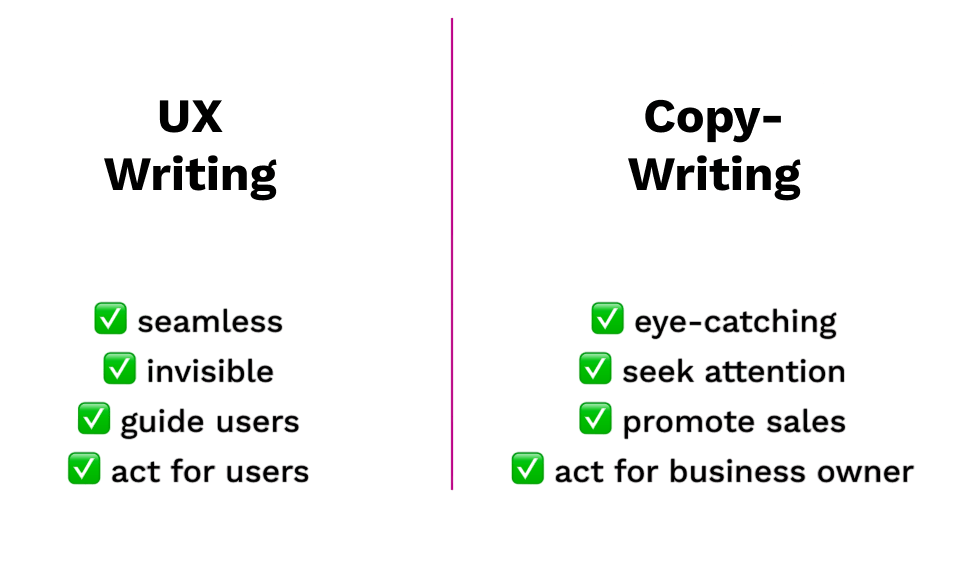
- Introduction to UX Writing
- Role and Responsibilities
- UX Writing vs. Copywriting
- Importance of Microcopy
- UX Writer Skills
- Writing for Error Messages
- Consistency in Tone and Voice
- Collaboration with Designers
- UX Writing Tools
- UX Writer Career Path
- Conclusion
Introduction to UX Writing
UX Writing emerged as a specialized discipline within the broader field of User Experience (UX) design. As digital products grew more complex, teams realized that interface text could not be left as an afterthought a principle emphasized in UI/UX Training, where microcopy, tone, and clarity are treated as integral components of user experience design. Poorly written copy often led to confusion, abandonment, or negative experiences. UX Writing ensures that the language within digital interfaces supports user goals and aligns with the overall brand voice. A good UX Writer doesn’t just write words; they understand user behavior, anticipate user needs, and collaborate with designers and developers to craft content that works harmoniously with visuals and functionality. UX Writing is about empathy putting yourself in the user’s shoes and making sure every word helps them achieve their task without unnecessary friction.
Ready to Get Certified in UI/UX Design? Explore the Program Now UI/UX Design Online Training Offered By ACTE Right Now!
Role and Responsibilities
The role of a UX Writer varies across companies but generally includes the following responsibilities:
- Creating Microcopy: Writing clear and concise text for buttons, menus, tooltips, and dialogs.
- Design Collaboration: Working with designers to ensure copy complements visuals and layouts.
- User Research: Participating in research sessions to understand how users interact with content.
- Maintaining Consistency: Defining and following tone, voice, and terminology guidelines.
- Error Handling: Writing helpful errors and empty state messages that reduce frustration.
- Accessibility Support: Ensuring copy is inclusive and understandable for diverse audiences.
- Documentation: Contributing to style guides and content systems for long-term consistency.
- Testing Content: Running A/B tests or usability studies to evaluate the effectiveness of microcopy.
In many organizations, UX Writers also act as advocates for the user, pushing for simplicity and clarity when competing business interests may complicate messaging.
UX Writing vs. Copywriting
At first glance, UX Writing and Copywriting may appear similar because both involve writing. However, they serve different purposes:
- Copywriting: Primarily marketing-focused. Its goal is persuasion convincing users to buy, sign up, or take action. Copywriters often work on landing pages, advertisements, email campaigns, and product descriptions.
- UX Writing: Functional in nature. Its goal is usability helping users navigate products and complete tasks without confusion. UX Writers work on interfaces, onboarding flows, forms, and in-app instructions.

For example, a copywriter might write a headline like “Upgrade to Premium and Unlock Exclusive Features,” while a UX writer would craft the button text “Upgrade Now” and the explanatory microcopy within the checkout flow.Both roles are essential, but UX Writing focuses on clarity, empathy, and guidance rather than persuasion.
To Explore UI/UX in Depth, Check Out Our Comprehensive UI/UX Online Training To Gain Insights From Our Experts!
Importance of Microcopy
Microcopy of the small bits of text that appear within digital interfaces plays a surprisingly big role in user experience. Though often overlooked, microcopy can determine whether users succeed or fail in completing a task a nuance explored deeply in UI/UX Training, where clarity, tone, and contextual guidance are treated as core pillars of effective interface design. Good microcopy reduces ambiguity. Instead of a vague button that says “Submit,” a well-written button might say “Send Feedback” or “Create Account,” clarifying the action. Microcopy also reassures users by providing confirmation messages like “Your changes have been saved” or by preventing errors through hints such as “Password must be at least 8 characters.” On the emotional side, microcopy can also express brand personality and create delight. Friendly error messages or encouraging onboarding copy can make the user feel supported rather than frustrated. Companies like Google, Slack, and Mailchimp are famous for their witty and empathetic microcopy, which enhances brand trust and user satisfaction.
UX Writer Skills
Becoming a successful UX writer requires a unique mix of writing expertise and user-centered design thinking:
- Clarity and Brevity: Writing concise text that communicates clearly.
- Empathy: Understanding user pain points and needs.
- Design Literacy: Knowledge of UX/UI principles to align words with visuals.
- Collaboration: Ability to work closely with designers, developers, and product managers.
- Research Orientation: Using data, user feedback, and testing to refine copy.
- Consistency Management: Maintaining brand voice across all touchpoints.
- Problem-Solving: Anticipating errors, misunderstandings, or roadblocks and addressing them with words.
- Adaptability: Switching tones depending on context (e.g., professional for banking apps, casual for lifestyle apps).

A UX Writer is essentially part-writer, part-designer, and part-researcher.
Looking to UI/UX Training? Discover the UI/UX Design Expert Masters Program Training Course Available at ACTE Now!
Writing for Error Messages
Error messages are one of the most critical areas of UX Writing. Poorly written errors can frustrate users and cause them to abandon tasks. The best error messages are:
- Clear: They explain what went wrong in plain language.
- Helpful: They guide users on how to fix the problem.
- Empathetic: They acknowledge user frustration without blaming them.
- Voice refers to the overall personality of the brand (e.g., friendly, professional, quirky).
- Tone is the adjustment of that voice based on context (e.g., cheerful during onboarding, serious during error messages).
- Design Tools: Figma, Sketch, and Adobe XD for writing directly in design prototypes.
- Content Management Tools: Notion, Confluence, or Google Docs for documentation and guidelines.
- Testing Tools: A/B testing platforms like Optimizely to validate content effectiveness.
- Collaboration Tools: Slack, Jira, or Trello for team communication and workflow management.
- Accessibility Checkers: Tools to ensure content meets accessibility standards.
For example, instead of saying “Error 404: Resource not found,” a better error message would be “We couldn’t find that page. Check the URL or return to the homepage.” Similarly, in forms, rather than simply stating “Invalid password,” a well-crafted message could be “Password must be at least 8 characters, with one number and one symbol.” This combination of clarity and guidance improves usability and user satisfaction.
Consistency in Tone and Voice
Consistency is crucial in UX Writing. A product’s tone and voice should reflect the brand identity while ensuring smooth communication. If an app’s messages shift between overly formal and casual, it can confuse users and weaken trust.
UX Writers often work with style guides or content design systems to maintain consistency across all digital touchpoints. This ensures that whether a user is signing up, making a payment, or encountering an error, the language feels cohesive and aligned with the brand’s values.
Preparing for UI/UX Design Job Interviews? Have a Look at Our Blog on UI/UX Design Interview Questions and Answers To Ace Your Interview!
Collaboration with Designers
UX Writers rarely work in isolation. They collaborate closely with UX/UI designers to ensure that copy and visuals complement one another. For example, if a button has limited space, the writer must adapt text to fit while maintaining clarity. Similarly, designers may adjust layouts to accommodate important explanatory text. Collaboration also extends to developers and product managers. Developers ensure that the copy works within technical constraints, while product managers align it with business goals. In this ecosystem, the UX Writer acts as a bridge, advocating for the user while balancing technical and business needs. Tools like Figma and Adobe XD have made this collaboration more seamless, as writers can directly edit text within design files and provide context for their choices.
UX Writing Tools
UX Writers use a variety of tools to streamline their work:
These tools allow writers to integrate their work into design and development workflows efficiently.
UX Writer Career Path
The UX Writer Career can be rewarding and diverse. Many UX Writers come from backgrounds in journalism, copywriting, technical writing, or marketing before transitioning into product design. Entry-level positions often start as content designers, content strategists, or junior UX writers. With experience, professionals may move into senior UX writing roles, leading content teams, or specializing in areas like conversational design (chatbots, voice assistants). At the top level, some UX writer careers become Content Design Managers or UX Directors, overseeing entire product experiences. The demand for UX Writers continues to grow as companies recognize the value of well-crafted interface text in driving user satisfaction and business success. Salaries are competitive, and opportunities span industries from tech and finance to healthcare and e-commerce.
Conclusion
UX Writing is a vital discipline that shapes how people interact with digital products. By focusing on microcopy, clarity, empathy, and consistency, UX Writers ensure that interfaces are not only functional but also enjoyable to use. They bridge the gap between design and communication, making complex systems simple and approachable a core objective of UI/UX Training, which equips learners to translate abstract workflows into intuitive, user-friendly interfaces. As technology continues to advance, the need for specialized writers who can craft user-centered content will only grow. Whether guiding users through an app, reassuring them during errors, or delighting them with thoughtful touches, UX Writers play a crucial role in shaping modern digital experiences. For anyone passionate about words, design, and user advocacy, UX Writing offers an exciting and fulfilling career path.




